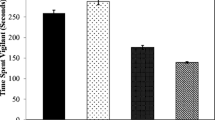Abstract
Vespula germanica wasps typically make consecutive trips between an undepleted food source and their nest. Hence, relocating a rewarded location is a recurrent activity during a wasp’s lifetime. While foraging, wasps continue searching over a previously rewarded location even when food is no longer available. Moreover, when food is displaced to a location nearby, wasps still visit the previously rewarded location. We aimed to study how the modification of the local context would affect the discovery of the novel food site. By displacing food and changing the local context after wasps had learned a certain task, we evaluated whether wasps found a new food location more rapidly than if contextual conditions remained unaltered. We found that when previously associated cues were modified, wasps were more likely to ‘give up’ searching at the old location than if these cues remained unaltered. Furthermore, we observed that a higher number of rewarding trials at the initial location resulted in greater time taken to detect the new feeder location.



Similar content being viewed by others
References
Archer ME (1998) The world distribution of the Euro-Asian species of Paravespula (Hym., Vespinae). Entomol Mon Mag 134:279–284
Cheng K (2000) How honeybees find a place: lessons from a simple mind. Anim Learn Behav 28:1–16
Cheng K (2005) Context cues eliminate retroactive interference effects in honeybees Apis mellifera. J Exp Biol 208:1019–1024
Collett TS, Collett M (2002) Memory use in insect visual navigation. Nature Rev Neurosci 3:542–552
Collett TS, Kelber A (1988) The retrieval of visuo-spatial memories by honeybees. J Comp Physiol A 163:145–150
Collett TS, Rees JA (1997) View-based navigation in hymenoptera: multiple strategies of landmark guidance in the approach to a feeder. J Comp Physiol A 181:47–58
Collett TS, Fauria K, Dale K (2003) Contextual cues and insect navigation. In Jeffery J (ed) The neurobiology of spatial behaviour. Oxford University Press, Oxford, NY. pp 67–82
D’Adamo P, Lozada M (2003) The importance of location and visual cues during foraging in the German wasp (Vespula germanica F.) (Hymenoptera: Vespidae). N Z J Zool 30:171–174
D’Adamo P, Lozada M (2007) Foraging behaviour related to habitat characteristics in the invasive wasp Vespula germanica. Ins Sci 14:383–388
D’Adamo P, Lozada M (2011) Cognitive plasticity in foraging Vespula germanica wasps. J Insect Sci 11:103
D’Adamo P, Corley JC, Sackmann P, Lozada M (2000) Local enhancement in the wasp Vespula germanica. Are visual cues all that matter? Insectes Soc. 47:289–291
Graham P, Durier V, Collett T (2007) The co-activation of snapshot memories in wood ants. J Exp Biol 210:2128–2136
Greene A (1991) Dolichovespula and Vespula, In: Ross KG, Matthews RW (eds) The social biology of wasps. Cornell University Press pp. 263–305
Jarau S, Hrncir M (2009) Social insects and the exploitation of food sources. In: Jarau S, Hrncir M (eds) Food exploitation by social insects: Ecological, behavioral, and theoretical approaches. CRC Press, Taylor & Francis Group, Boca Raton
Lozada M, D’Adamo P (2006) How long do Vespula germanica wasps search for a food source that is no longer available? J Insect Behav 19:591–600
Lozada M, D’Adamo P (2009) How does an invasive social wasp deal with changing contextual cues while foraging? Environ Entomol 38:803–808
Lozada M, D'Adamo P (2011) Past experience: a help or a hindrance to Vespula germanica foragers? J Insect Behav 24(2):159–166, doi:10.1007/s10905-010-9244-6
Menzel R (2009) Learning and memory in invertebrates: Honey bee. In: Squire LR (ed) Encyclopedia of Neuroscience, vol 5. Academic, Oxford, pp 435–439
Menzel R, Geiger K, Chittka L, Joerges J, Kunze J, Muller U (1996) The knowledge base of bee navigation. J Exp Biol 199:141–146
Moreyra S, D’Adamo P, Lozada M (2006) Odour and visual cues utilized by German yellow-jackets (Vespula germanica) while re-locating protein or carbohydrate resources. Austr J Zool 54:393–397
Moreyra S, D’Adamo P, Lozada M (2012) Cognitive processes in Vespula germanica wasps when relocating a food source. Ann Entomol Soc Am 105(1):128–133
Raveret-Richter M (2000) Social wasp (Hymenoptera: Vespidae) foraging behaviour. Annu Rev Entomol 45:121–150
Shettleworth SJ (2001) Animal cognition and animal behavior. Anim Behav 61:277–286
Acknowledgments
We are very grateful to Audrey Shaw for the English revision of the manuscript and two anonymous reviewers whose comments greatly improved a first version. This study was partially funded through a grant from CONICET (PIP N° 114200080100207). We also acknowledge support from the CRUB, Universidad Nacional del Comahue. P. D’Adamo and M. Lozada are Research Fellows of CONICET
Author information
Authors and Affiliations
Corresponding author
Rights and permissions
About this article
Cite this article
D’Adamo, P., Lozada, M. How Context Modification can Favor the Release of Past Experience in Vespula germanica Wasps, Enabling the Detection of a Novel Food Site. J Insect Behav 27, 395–402 (2014). https://doi.org/10.1007/s10905-013-9434-0
Revised:
Accepted:
Published:
Issue Date:
DOI: https://doi.org/10.1007/s10905-013-9434-0




